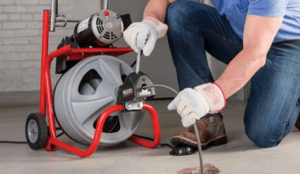Drain Cleaning Perth involves clearing obstructions in your plumbing lines. It prevents slow draining, which saves water and lowers your utility bill. It also prevents clogs that cause overflowing toilets and sewer line leaks or even bursting.
There are several methods for drain cleaning including drain snakes, hydro-jetting and enzyme cleaners. Using these tools with the proper Personal Protection Equipment (PPE) is important.

Grease, oils, and fats (FOG) are a frequent culprit of drain clogs. They collect in drain pipes and solidify, restricting water flow and causing foul odors. Although FOG clogs are not uncommon, they can be prevented with regular drain cleaning.
The easiest way to remove grease from a drain is to pour boiling water down the clogged pipe. The high temperature melts the grease, making it easy to wash away with a subsequent flush of hot water. However, if the clog persists, you may need to use a more intense method.
One option is to use a caustic drain cleaner. A caustic chemical is much more effective at dissolving dense grease than boiling water. However, it is harmful to your pipes and the environment if it isn’t diluted with plenty of water. A safer and more environmentally friendly alternative is to pour a pot of boiling water down the drain after using a caustic solution.
Another useful method for removing grease from your drains is to use dish soap. This is specifically designed to break up grease particles when washing dishes, and it can work wonders on your drains. Simply squirt a generous amount of the liquid down your drain, and then immediately follow it with a pot of boiling water.
Baking soda is also a useful grease-fighting tool. When a cup of baking soda is combined with vinegar, the acidity from the vinegar causes a fizzing reaction that helps break down and wash away the grease in your pipes. If you have a particularly stubborn grease clog, try pouring the mixture down the drain in several stages, allowing it to sit for several seconds between each pour.
Finally, you can flush your drains with a mixture of hot water and baking soda on a weekly basis to prevent FOG build-up. Just be sure to use a kettle full of boiling water, and pour it down the drain in sections, allowing each batch of hot water to rest for a few minutes before the next. This is the best and safest method for keeping your drains clear of grease and oil.
Hair
Hair often ends up in your drains and can clog them over time, restricting water flow. This can cause unpleasant odors as the organic debris decomposes and can lead to more serious problems such as a complete blockage that requires professional intervention. Fortunately, there are many ways to remove hair from your drains and keep them clean and flowing properly.
One of the easiest and most effective methods is to use a product designed to dissolve hair. These products are available at most hardware stores and can be poured down your drain to break up the hair and other debris. Be sure to follow the instructions on the package for safe usage.
Another simple method is to pour a mixture of baking soda and vinegar down your drain. The chemical reaction can help to break down and dislodge hair, as well as eliminate unpleasant odors from your drain. Simply pour at least a cup of baking soda down your drain, followed by a cup of vinegar. Wait a few minutes for the chemical reaction to take effect, then flush the drain with hot water.
For larger clumps of hair that are difficult to dislodge, you can try using a pair of tweezers or pliers to pull it out of the drain. This can be particularly helpful for removing hair that is caught in a bend or crease in your drain.
If your hair clog is too serious for any of these methods, you can try using a drain snake or auger. These tools can be inserted into the drain to grab and pull out the hair, but they are best used for large clogs that aren’t too deep.
If you don’t have a drain snake or auger, you can try using a coat hanger. Straighten out the end of the hanger and create a small hook on one side, then insert it into your drain and fish out the hair. You can also use a long stick or rod with barbs on the end that can be stuck into your drain and twisted to catch the hair.
Biological Debris
The drains in our plumbing systems play a critical role in delivering wastewater away from our homes, businesses, and public spaces. Regular drain cleaning, along with proactive maintenance habits, can keep them running smoothly and efficiently for years to come. However, when clogs and other issues arise, professional drain cleaning and repair services can be necessary to address the issue immediately and prevent long-term damage.
Many people use harsh chemical cleaners like Drano to clear clogged drains, but these chemicals can be damaging to your pipes over time. They also can irritate your skin, eyes, and lungs if they come into contact with them, so it’s important to look for safer, healthier alternatives.
One of the best drain cleaning solutions is a simple combination of baking soda and vinegar. Pour half a cup of baking soda down the drain, followed by a cup of vinegar. The fizzing reaction will break up and dissolve clogs, while simultaneously deodorizing the drain. Then, rinse with hot water for a clean, fresh-smelling pipe.
Another natural drain cleaning option is to use a septic-safe biological cleaner, which uses bacteria or enzymes to break down organic material in pipes without the negative environmental impact of chemical cleaners. Though they may take longer to work than chemical cleaners, bio-enzyme cleaners are better for the environment and your plumbing system.
For a more thorough drain cleaning, a plumber can use a hydro-jetting machine that sends high-pressure water through a hose into the drain. This process thoroughly scourers the entire length of pipe, breaking up and flushing out all contaminants that could clog the drain again in the future. This is a much more costly option, but it’s also the most effective.
Regardless of the drain cleaning method you choose, it’s always recommended to wear protective gear when performing manual drain cleaning. This includes a pair of heavy-duty gloves that are resistant to tearing and punctures, safety goggles to prevent splashes and aerosols from contacting your eyes, and hearing protection such as earplugs or earmuffs to safeguard against potential long-term noise exposure.
Sewer Line Issues
Sewer lines connect your home’s drains to the municipal sewer system or septic tank. Though buried underground, the lines remain out of sight until they experience problems. A clogged or broken sewer line can result in raw sewage backing up into your home, which poses health risks and damages your plumbing fixtures.
The best way to prevent sewer line clogs is by using drain cleaners that are safe for your pipes, such as enzyme cleaners. These cleansers dissolve grease, soap scum, and other debris that accumulates inside your drains without damaging the pipe itself. In addition, avoiding flushing non-biodegradable materials like cotton swabs, coffee grounds, and sanitary items can reduce the risk of a blocked line.
If your home’s main drains become clogged, shut off the water supply and call a plumber immediately. Clogged sewer lines can cause raw sewage to back up into bathrooms, showers, and sinks. A professional can use a camera to find the source of the problem and recommend drain cleaning or sewer line replacement services.
Cracked or damaged pipes can also lead to clogs and backups. These issues are typically caused by corrosion, extreme weather conditions, or tree root intrusion. If the issue is minor, a plumber may be able to repair the pipe with a trenchless method such as pipe bursting or relining.
If the problem is severe, a plumber will need to replace the entire sewer line. These repairs are usually more cost-effective than repairing individual drains. A specialist can install a new, durable line with minimal damage to your yard and landscaping.
A sewer line that becomes misaligned or collapsed can be difficult to spot. However, if you notice large puddles on your lawn, smelly odors coming from your drains, or unexplained sewage backups in your home, it’s time to call a plumber.
Though you’re responsible for your home’s plumbing, the city is responsible for all lateral and main sewer lines that extend beyond your property. The best way to keep your sewer line in good shape is by having it cleaned and inspected at least once per year. A professional can use pressurized water to dislodge blockages, remove roots, and ensure that all parts of the line are in good condition.








